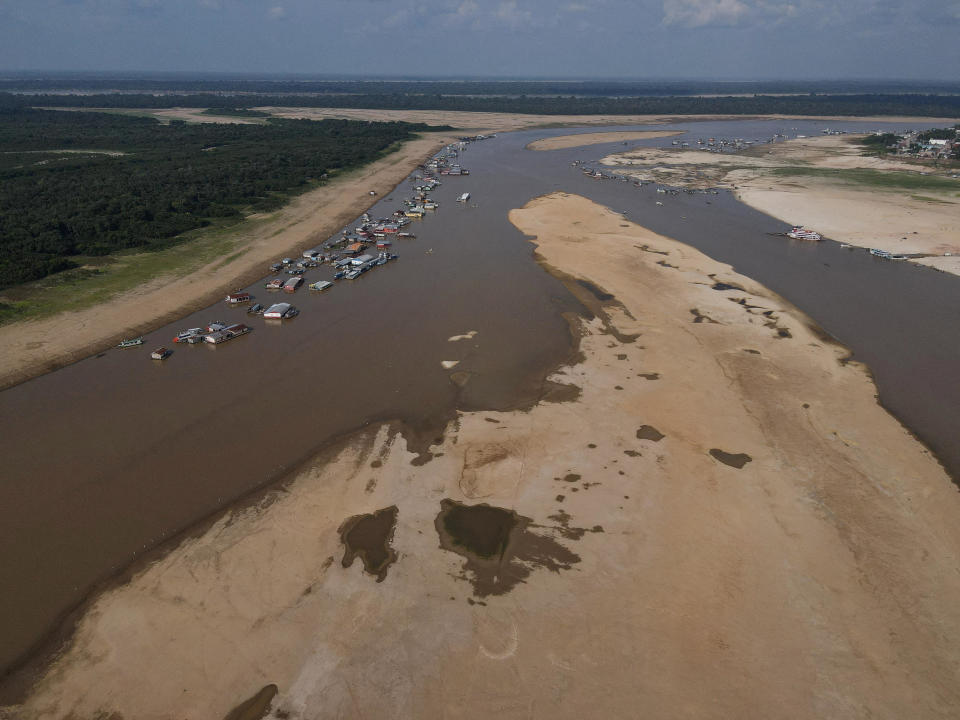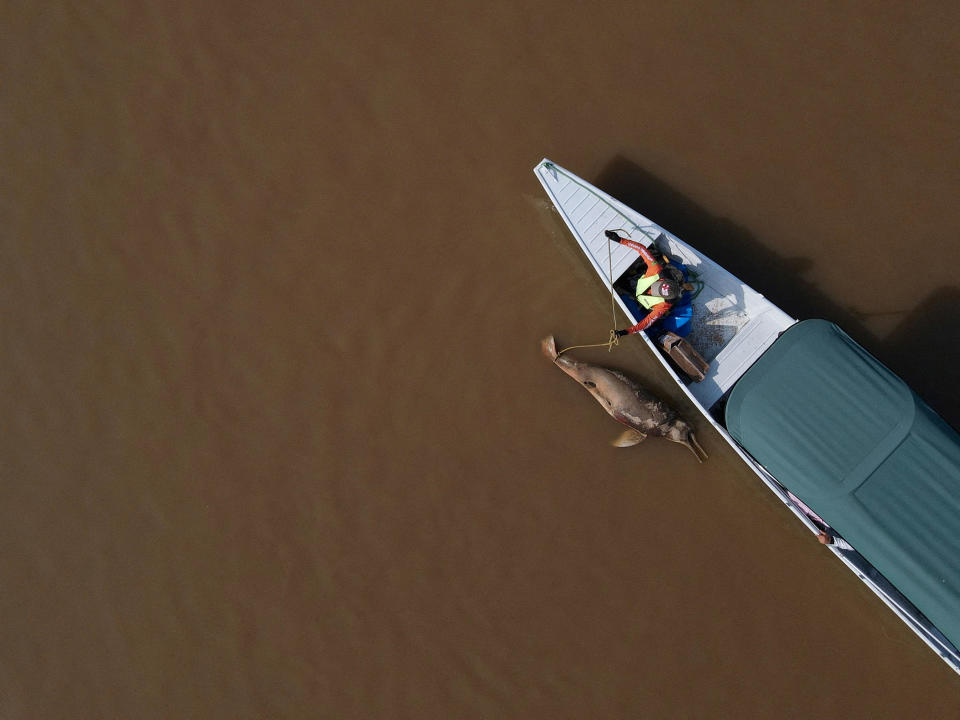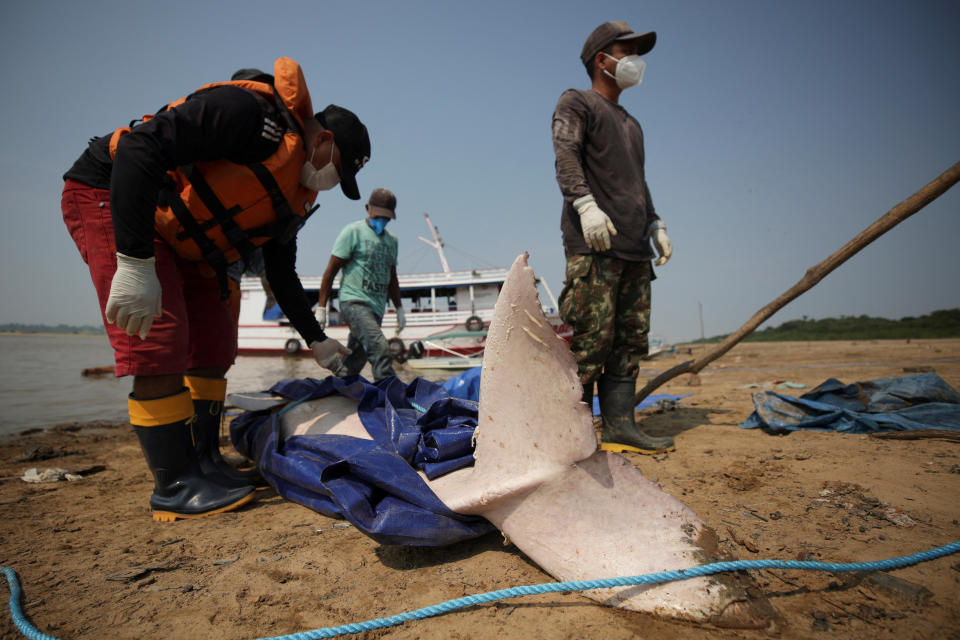150 dolphins die in Amazon lake within a week as water temps soar
An ongoing drought in the Amazon — combined with the effects of climate change and El Niño — caused temperatures in Brazil's Lake Tefé to soar and led to the deaths of more than 150 dolphins at the end of September, officials said. Within a week, experts say, roughly 10% of the local dolphin population was found dead, as were hundreds of fish, as water temperatures reached hot tub temperatures.
Officials from World Wildlife Fund Brazil said that 153 dolphins were found dead the week of Sept. 23, including 130 pink dolphins and 23 tucuxi dolphins. Both are listed as endangered on the IUCN Red List and the latter of which are considered "the guardians of rivers and a symbol of good luck," according to RiverDolphins.org.
Researchers from WWF-Brazil, as well as the Mamirau Institute for Sustainable Development, said the unusual mortality event was caused by an ongoing drought. According to WWF-Brazil, "the Amazon is experiencing an extreme drought that has reduced the flow of its main rivers," two years after the area saw significant rainfall that flooded "entire cities for months." On Monday, the Rio Negro for example, reached its lowest water depth since 1902.

Lower levels of precipitation have been linked to higher temperatures in bodies of water.
Earlier this week, new research published in the journal Hydrological Processes found that droughts "have significant implications for river water temperature extremes" as radiation during these periods is more intense while water levels are lower and river velocities slow. As global average temperatures continue to rise, namely from the burning of fossil fuels, such issues are only expected to get worse.
"Rising river water temperatures can have significant and often detrimental implications for aquatic life, impacting both individual species and entire ecosystems," study co-author and University of Birmingham professor David Hannah said. "Drought conditions often coincide with high atmospheric temperatures and such trends will become more intense and frequent with climate change."
The higher water temperatures in Lake Tefé were at least in part caused by the ongoing drought. At one point during the week of the mass dolphin casualties, temperatures hit as high as 39.1 degrees Celsius, or nearly 102.4 degrees Fahrenheit. At that temperature, the water was as warm as a hot tub, which according to the Consumer Product Safety Commission, is typically set between 100 and 102 degrees Fahrenheit.
The average maximum temperature over time for the lake is significantly lower at 89.6 degrees Fahrenheit, oceanographer Miriam Marmontel, who is helping research the issue, said through the World Wildlife Fund. Marmontel believes the more than 12-degree difference triggered thermal stress in the animals.

Both the drought and water temperatures "are directly related to what happened," the institute said, according to a translation, although other contributing factors to the animals' deaths have "not yet been ruled out, such as water contamination or animal disease."
However, of the 104 deceased dolphins that have been necropsied, results from 17 show that "there is no evidence of an infectious agent linked to the primary cause of mortality," the institute said. The algae egulena sanguinea, which can cause fish to die, was found in the water since Oct. 3, researchers said "there is no evidence that its toxin is related to dolphin mortality nor has it caused the death of fish in Lake Tefé."
"Of all the environmental and biological variables that we have analyzed, the only one that has shown an anomalous is the water temperature," they added. "The fish mortality found is normal for extreme drought events in region."

Mariana Paschoalini Frias, a conservation analyst at WWF-Brazil, described the mass deaths as "appalling" – and could be a sign of what's to come for others in the area, including people.
"The impact of the loss of these animals is enormous and affects the entire local ecosystem," she said. "Porpoises are considered 'sentinels.' In other words: they are indicative of the health of the environment where they live. What happens to them is reflected in the other species that live around them, including humans."
WWF-Brazil said that a barrier of wooden stakes has now been put up to try and prevent more dolphin deaths and move the animals to "deeper, less hot areas."
Watch: Biden meets with Israeli first responders, families of terror attack victims
Joran van der Sloot admitted to killing Natalee Holloway, judge says
Jim Jordan loses support on 2nd House speaker ballot; 1 member votes for John Boehner

